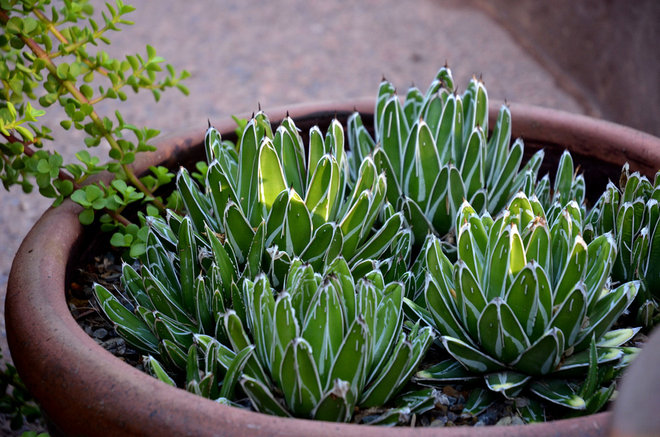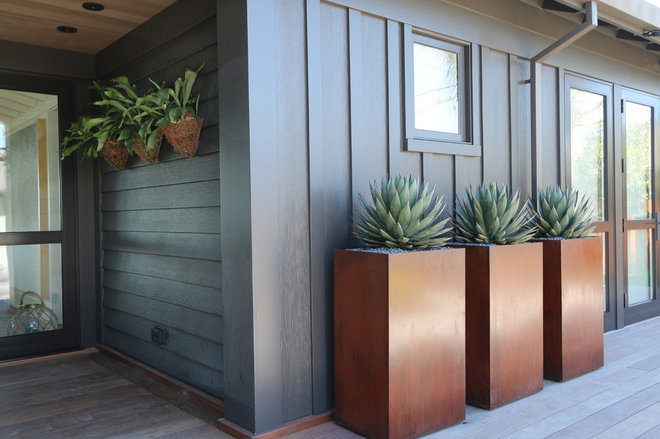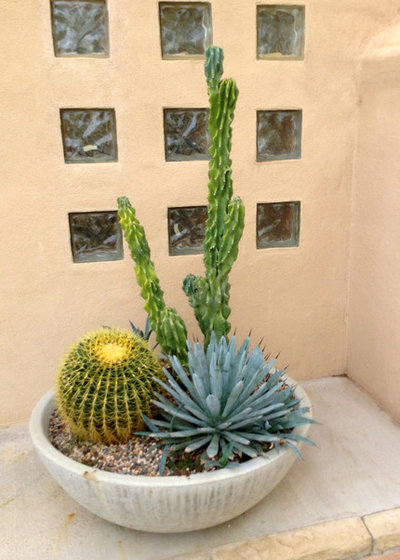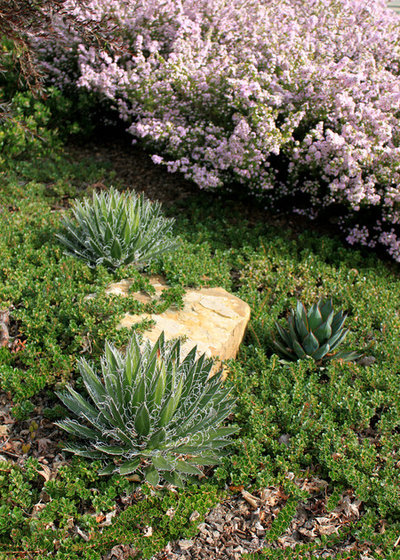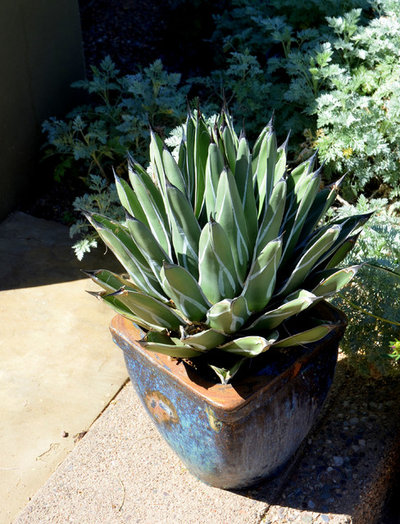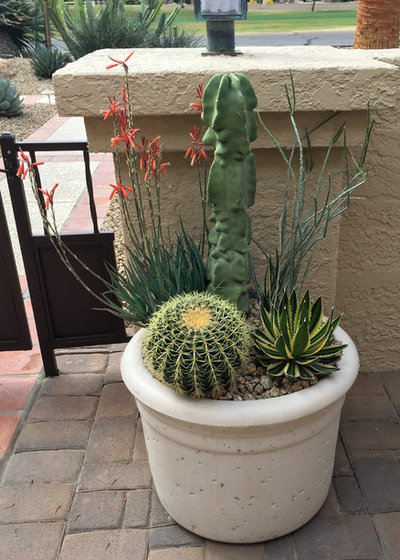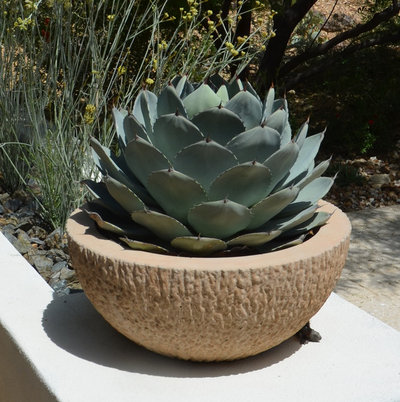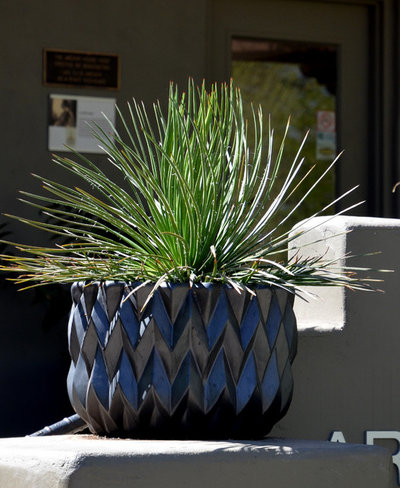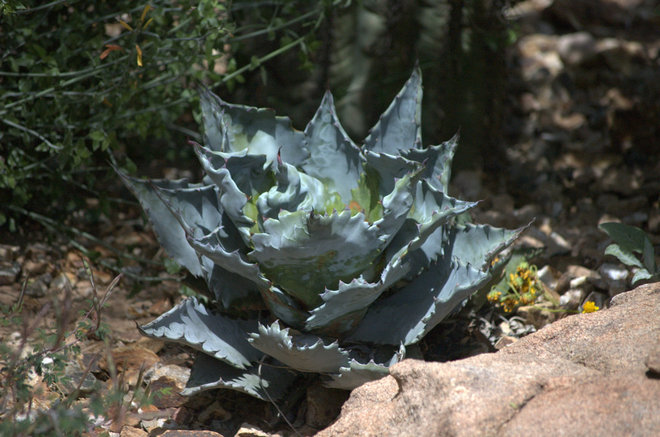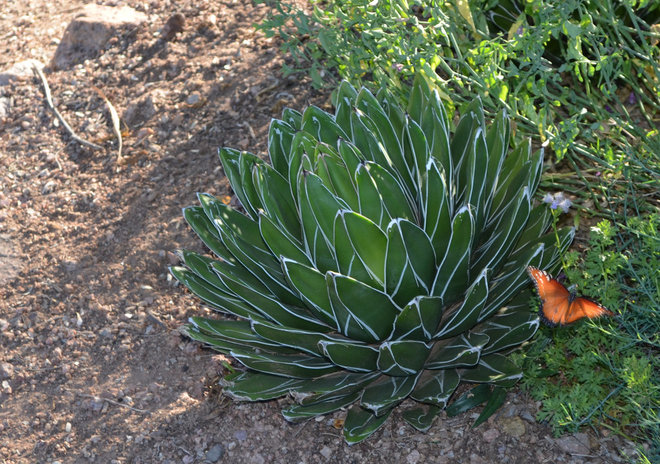Here are 10 agave species that are perfect for smaller areas, with varying cold tolerances, exposure requirements and sizes to ensure there is one right for you.
(Agave victoria-reginae ‘Compacta’)
Native to Mexico
This smaller version of the slow-growing Queen Victoria agave barely reaches 12 inches wide. The dark green leaves with bright white margins make this species highly desirable. This miniature native of Mexico doesn’t produce offsets (volunteers) like many other species of agave do, and it looks great when planted in groups of three or five.
Where it will grow: Hardy to 10 degrees Fahrenheit, or minus 12 degrees Celsius (USDA Zone 8; find your zone)
Light requirement: Full sun is best, but it can handle filtered shade for a few hours a day
Mature size: Up to 8 inches to 1 foot tall and wide
(Agave ‘Blue Glow’)
Hybrid of Agave attenuata and Agave ocahui
Every few years there is a new plant arrival that takes the gardening world by storm. In the succulent world, ‘Blue Glow’ agave has done just that. While it doesn’t resemble its parents, the mixing of their genes created an agave that has dark blue-green leaves with yellow and red margins that seemingly glow when backlit by the sun.
Where it will grow: Hardy to 20 degrees Fahrenheit, or minus 6.7 degrees Celsius (Zone 9)
Light requirement: Full sun is best, but it can handle filtered shade for a few hours a day; filtered sun is best in low-desert zones
Mature size: 2 feet tall and wide
3. Black-Spined Agave
(Agave macroacantha)
Native to southern Mexico, including Oaxaca
Black-spined agave’s powder-blue leaves and maroon tips provide great color contrast in the garden. This agave produces numerous offsets, creating a clumping appearance. Its narrow leaves and open rosette growth habit add welcome texture in containers.
Where it will grow: Hardy to 25 degrees Fahrenheit, or minus 3.9 degrees Celsius (Zone 9)
Light requirement: Full sun to filtered shade
Mature size: 10 to 16 inches tall and wide
(Agave schidigera)
Native to Mexico, including Chihuahua and south through central Mexico
The curly white fibers that grace this small agave’s bright green leaf edges capture the attention of passersby. White markings on the leaves increase Agave schidigera’s visual appeal.
Where it will grow: Hardy to 15 degrees Fahrenheit, or minus 9.4 degrees Celsius (Zone 8)
Light requirement: Full sun or light shade; filtered or afternoon shade is recommended in low-desert gardens
Mature size: 1 foot tall and 1 foot to 2 feet wide
(Agave nickelsiae syn. Agave ferdinandi regis)
Native to Coahuila, Mexico
The resemblance of this agave to Queen Victoria agave is unmistakable, as both have dark green leaves, similar white margins and sharp terminal tips. At one point, it was thought that King Ferdinand agave was a naturally occurring hybrid ofAgave victoria-reginae; however, this is no longer considered to be true. Its unusual shape and open rosette form make it look great planted singly in containers.
Where it will grow: Hardy to 10 degrees Fahrenheit, or minus 12 degrees Celsius (Zone 8)
Light requirement: Full sun
Mature size: 1 foot to 2 feet tall and wide
6. Agave Lophantha
(Agave lophantha)
Native to the Rio Grande area of Texas and adjoining Veracruz, Mexico
The leaves of this succulent are a lush green color, with curved maroon teeth along the edges. The center of the leaves often has a lighter stripe that runs the length. There are several varieties of Agave lophantha,including ‘Quadricolor’, which has yellow margins on bright green leaves. Plant it with other succulents for maximum effect.
Where it will grow: Hardy to 10 degrees Fahrenheit, or minus 12 degrees Celsius (Zone 8)
Light requirement: Full sun to light shade
Mature size: 1 foot to 2 feet tall and wide
(Agave parryi var. truncata)
Native to central Mexico, including Durango
Wide blue-gray leaves with maroon spines bear a striking resemblance to artichoke leaves, hence this Mexican native’s common name. Prized by many for its beauty, artichoke agave is a popular choice for container gardening, whether used in rows of three in a long, narrow container or singly in a modern pot. It does produce a few offsets, which can be used elsewhere in the garden or given to friends.
Where it will grow: Hardy to 10 degrees Fahrenheit, or minus 12 degrees Celsius (Zone 8)
Light requirement: Full, reflected sun or filtered shade
Mature size: 3 feet tall and wide
(Agave geminiflora)
Native to Nayarit, Mexico
The finely textured leaves of this bright green agave set it apart from most other species. Twin-flowered agave tolerates a range of exposures, from full reflected sun all the way to full shade, which makes it an asset in most situations.
Where it will grow: Hardy to 15 degrees Fahrenheit, or minus 9.4 degrees Celsius (Zone 8)
Light requirement: Full reflected sun to full shade
Mature size: 3 feet tall and wide
(Agave colorata)
Native to Sonora, Mexico
The decorative leaves of this midsize agave species are loaded with interesting features, including well-defined imprinted patterns and deeply toothed edges, which add a wavy texture to the landscape. Mescal ceniza’s blue-gray color adds a visually cooling element to hot outdoor spaces.
Where it will grow: Hardy to 15 degrees Fahrenheit, or minus 9.4 degrees Celsius (Zone 8)
Light requirement: Full sun
Mature size: 2 feet tall and wide
(Agave victoria-reginae)
Native to the Chihuahuan Desert region of Mexico
Often described as the most beautiful agave, this one, named after Queen Victoria, lives up to its queenly name with dark green coloring and vibrant white markings. The tight rosette shape and smooth leaf edges that terminate into a single spike add to Queen Victoria’s visual appeal.
Where it will grow: Hardy to 10 degrees Fahrenheit, or minus 12 degrees Celsius (Zone 8)
Light requirement: Full sun
Mature size: 18 inches tall and wide
See how to grow Queen Victoria agave
Agave growing tips:
- First select a pot, with a drainage hole, that is a little larger than the root ball, as agaves do better when their roots are slightly crowded. No saucer is needed, and is in fact discouraged, as sitting water can lead to overly moist soil.
- All agaves require well-drained soil, which can be created using one part compost, one part sand and one part perlite or pumice.
- Water when the top two-thirds of the soil has dried out. Water deeply, until water runs out the bottom. Watering should be done weekly in summer when temperatures are above 100 degrees Fahrenheit and very little in winter.
- Fertilize once a month during the growing season, which is typically late spring and summer.
- Repot every three years or so once the roots have little soil left to grow in.
Originally published on HOUZZ by Noelle Johnson
